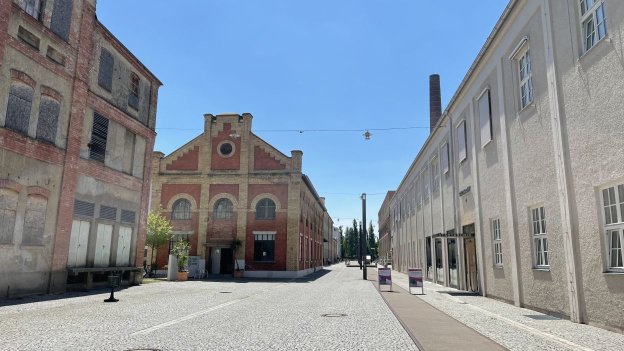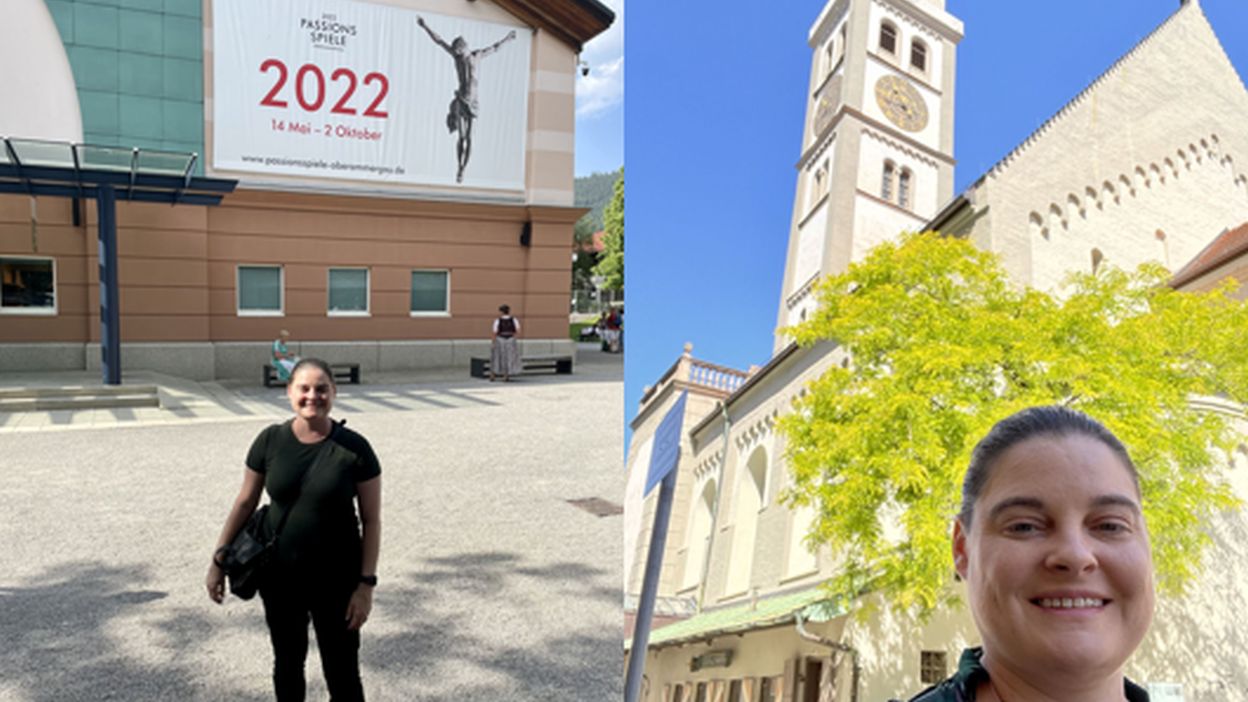Emily Hicks
 Privat
Privat
The Staatsarchiv Augsburg
Overall, my stay in Germany was excellent. If given the opportunity to return, either for research or just for fun, I would definitely come back for another trip.
Emily Hicks spent two months in Augsburg as part of a Respekt & Wertschätzung Scholarship, during which she was able to further her doctoral project with the help of records from the Staats- und Stadtbibliothek (State and Municipal Library) and the Staatsarchiv (State Archive).
Below, she shares her research on the history of music in the modern era:
For my project I planned a two-month research trip to Augsburg, Germany for two major purposes. The first was to visit two archives in the city, the Staats- und Stadtbibliothek Augsburg and the Stadtarchiv Augsburg, to gather information on the city musicians (Stadtpfeifer) from Germany’s early-modern period. The second was to study the acoustical properties of public buildings from the era. My ultimate goal is to use the archival materials and acoustical studies of the city’s public spaces to support my thesis that musicians employed in the cities of early modern Germany were just as culturally significant to the societies they represented as their church- and court-employed counterparts.
My schedule for the two months stayed fairly consistent. Each week I spent Mondays and Tuesdays visiting the Staat- und Stadtbibliothek Augsburg and then the rest of the week at the Stadtarchiv. On the weekends I attended concerts and church services with the intention—not only to soak up the local music as much as possible—but also to focus on the soundscape aspects of my research. Some of the churches and public buildings are in similar conditions (structurally, acoustically) to how they were during the early modern period, and therefore I was able to study some aspects of the soundscape as it would have been heard during the period, make recordings, and do some decibel analysis of both ambient sound and musical sound. For this part of my research, I had brought my Tascam DR-05x digital recorder that allows me to record hours’ worth of material while registering decibel levels. The decibel information on the recorder is only available in real-time however, so I also used an application on my phone that allowed me to record decibel levels and save the information over time in one of four frequency weightings: A, B, C, Z. I primarily used A, which reads the decibels as heard by the human ear, and Z, which is a flat reading without any reductions of higher or lower levels.
The Staats- und Stadtbibliothek Augsburg was very welcoming, and the staff was wonderful. I met with the library manager Dr. Karl Georg Pfändtner, and deputy head Dr. Berthold Kress in the first days of my visit and both were exceedingly helpful in making sure my stay was a great one. The library holds manuscripts from the churches and other institutions of the region and before arriving in Augsburg I had sent them a list of the manuscripts I was hoping to see, which they, in turn, put aside for me. Several of my requested books had been sent to Berlin for digitization by the time I arrived and therefore were inaccessible, but this meant that I could focus going through the other sources and inspect the digital versions at a later date. The library ended up being the least fruitful of the two archives in terms of number of materials, but I was still able to find some that will benefit my research, including a musical treatise, an eighteenth-century church accounting book, and a book of Meistersinger songs from the sixteenth century.
The Stadtarchiv Augsburg was also very open and prepared for my visit. As with the library, I had provided a list of documents I was hoping to examine and the Stadtarchiv had these set aside for me when I arrived. They allowed pictures to be taken of the documents for research purposes (not a common allowance), which helped me work through all the documents I needed to see within my timetable without much stress. The people working in the archive were very helpful and friendly, providing, in many cases, more than what I had asked for (or documents I was unaware they had) but they somehow knew I needed. Very few of them spoke English and I loved the opportunity to work on my German in a professional context.
My primary goal investigating the documents of the Stadtarchiv was to review the Baumeisterbücher. These are financial records kept by the city council that span from the 1320s to 1806. I was excited to find the lists of payments for the Stadtpfeifer for each year from 1506-1789, which will help me establish the amount of financial support the musicians received from the local government, and thus assess the significance of the musicians in the cultural life of the city. In addition to these, the archivists provided me with hundreds of legal documents submitted by local musicians to the city council, including the Stadtpfeifer, freelance musicians, and the Meistersingers (singers who competed in competitions based on strict composition and style rules). These documents cover a wide range of topics such as marriage licenses, access to performance opportunities, and disputes over publishing rights. In addition to providing context for financial information found in the Baumeisterbücher, these documents help to build the social aspect of my research. Examining how the council responded to these various situations will help establish how much the city recognized their musicians as cultural collateral for the overall perceived significance of the city and its citizens.
The next steps in my research are to interpret the financial data I gathered from the Baumeisterbücher and to examine the legal documents with an eye on how the city was supporting their employed musicians (and how this benefited the public perception of the city). My plan is to compare the yearly incomes of the Stadtpfeifer to other professions the city directly employed such as midwives, carpenters, and civil servants. By doing so I can compare the implied value that the city placed on these professions and how the musicians stood within that system.

Privat
left: The Passionsspiele in Oberammergau; right: St. Peter am Perlach
Outside of my research, one of my favorite things was visiting the variety of restaurants available in Augsburg, especially the traditional Bavarian and Italian ones. I was thrilled with all the different types of sausages I could find in the restaurants since this is a favorite food of mine and one of my favorite things to order was Spätzle because it is the perfect pairing to all the tasty sausages and gravies I had while I was there. The differences in the German grocery stores was also something I fell in love with immediately. First of all, the listed prices include the taxes—something American pricing does not do and is frustrating when on a budget. I’ve experienced this in other countries as well and am confused why my home country cannot do the same. I also loved the checkout process at typical grocery stores. In America, the cashier or the person bagging the groceries will often try to chat with you. This is nice, but as an introverted person, I enjoyed the relative lack of conversation expected at the German checkouts.
I had several opportunities to enjoy some exciting cultural events during my stay as well. Augsburg had their Lange Kunstnacht (Long Art Night) festival while I was there and I was able to attend concerts in the Rathaus (City Hall), the Maximilian Museum, St. Anna’s church, St. Ulrich’s Basilica, and the Augsburg Cathedral. One of my best memories was attending the famous Passionsspiele in Oberammergau. I had not planned on going during my trip because of finances, despite the fact that it only occurs every ten years and would be a very difficult trip from America otherwise. However, during my first week I met a couple that offered me one of their extra tickets and I managed to take the train to Oberammergau to attend the play. The music and the acting were wonderful! This ended up being the experience of a lifetime and I am extremely thankful that I got the surprise offer and had the time to attend.
For a brief period in the middle of my research trip my husband was able to join me from America, and we took day trips to other places in Bavaria. We visited the Deutsches Museum in Munich to see their musical instruments, alchemy, and cryptology exhibits and then spent the evening at the Hofbräuhaus. On another day we traveled to Schwangau to tour the Neuschwanstein and Hohenschwangau Castles. We also took some time to visit the Andechs Monastery to tour the church and have lunch in their biergarten on the recommendation of a friend. It definitely ended up being one of the highlights of our trip and a place I have now recommended to several others.
Overall, my stay in Germany was excellent. If given the opportunity to return, either for research or just for fun, I would definitely come back for another trip. Receiving the Respekt & Wertschätzung Scholarship by the DAAD-Stiftung is such a huge honor for me and I would not have been able to conduct my research, or have the countless experiences I did, without it. I feel the two months spent in Augsburg will have a definite and exciting impact on where I go from here, both in my career and in my future cultural adventures.
As of November 2022.


